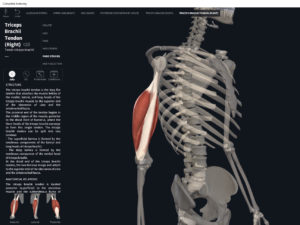Anatomy & Physiology: Muscles—Triceps Brachii.
Structure.
- Origin: long head—infraglenoid tubercle of scapula, a projection inferior to glenoid cavity; lateral head—lateral and posterior surfaces of humerus superior to radial groove; medial head—posterior surface of humerus inferior to groove for radial nerve.
- Insertion: olecranon process of ulna.
Function.
- Concentric action: elbow extension; shoulder extension. Adduction of shoulder (long head); shoulder extension (glenohumeral joint).
- Reverse mover action: arm extension at elbow; scapular downward rotation; protraction and lateral tilt of scapula.
- Eccentric action: controls/restrains/slows elbow flexion, shoulder flexion, shoulder abduction, horizontal flexion, scapular upward rotation, scapular retraction, scpular medial tilt.
- Isometric action: stabilization of the elbow and shoulder girdle.
- Innervation: radial nerve.
- Arterial supply: deep brachial artery; circumflex scapular artery.
Clinical Significance.
References
Biel, A. (2015). Trail guide to the body: A hands-on guide to locating muscles, bones and more.
Cedars-Sinai. (2018). Vertebrae of the spine. Retrieved from https://www.cedars-sinai.org/health-library/diseases-and-conditions/v/vertebrae-of-the-spine.html
Clark, M., Lucett, S., Sutton, B. G., & National Academy of Sports Medicine. (2014). NASM essentials of corrective exercise training. Burlington, MA: Jones & Bartlett Learning.
Jenkins, G., & Tortora, G. J. (2012). Anatomy and Physiology: From Science to Life, 3rd Edition International Stu. John Wiley & Sons.
Muscolino, J. E. (2017). The muscular system manual: The skeletal muscles of the human body.



